Friday, October 16, 2015
Why parking lights?
One good thing about post-1990 autos: Carmakers FINALLY understand the basics of human vision and perception. It's amazing that it took 100 years to figure these things out. For safety you need to SEE, and you need to BE SEEN. Not mysterious. Rules for boats and trucks comprehended these points much earlier.
At first even seeing FORWARD wasn't important. Polistra illustrates this with her Detroit Electric. The driver sat in back, chatting with passengers in both front seats.
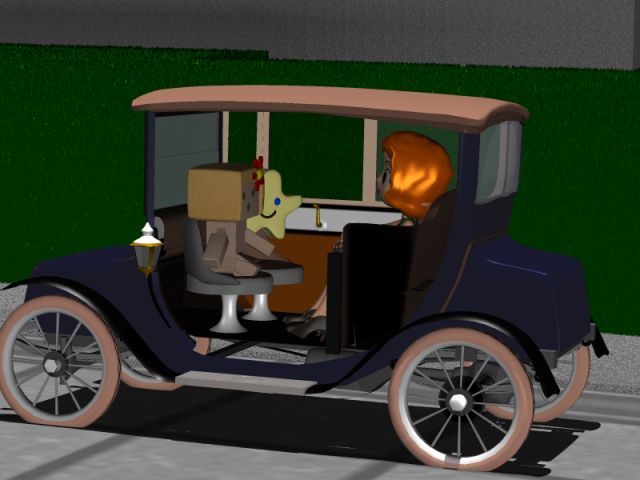 After the driver moved firmly into the front, forward and sideways vision were usable. Backward vision took amazingly long to establish. Inside mirrors were standard by 1920, but essentially useless because the rear window was tiny, often too high to look downward, and often covered by shades or blinds. Rear windows finally opened up and straightened up in 1950.
The left side mirror was purely optional and rather rare until the mid-50s. Right side mirrors didn't become common until the '80s. Internal adjustments for both mirrors, especially the right one, were obviously needed and technically easy.... but weren't even available on luxury cars until the '60s and not standard until the '90s. Before these levers or motors, both mirrors were essentially impossible to adjust, which meant they were mostly useless.
Headlights also belong to the SEEING side, and developed in a 'logical' way, taking advantage of technology. From oil lamps to incandescent to halogen, getting brighter and more penetrating at each step.
Taillights, on the BEING SEEN side, were far less 'logical'. One taillight, sometimes centered and sometimes down low on the left side, was sufficient until 1935. This was stupid and dangerous. At night you need to see the BOUNDARIES of the car, and you need to judge how far it is from you. You need lights on both sides, preferably close to eye level, and out at the far edges of the car.
The least sensible of all is parking lights. Completely useless. Never served any purpose at all.
Parking lights developed from coach lights, as Polistra shows here.
After the driver moved firmly into the front, forward and sideways vision were usable. Backward vision took amazingly long to establish. Inside mirrors were standard by 1920, but essentially useless because the rear window was tiny, often too high to look downward, and often covered by shades or blinds. Rear windows finally opened up and straightened up in 1950.
The left side mirror was purely optional and rather rare until the mid-50s. Right side mirrors didn't become common until the '80s. Internal adjustments for both mirrors, especially the right one, were obviously needed and technically easy.... but weren't even available on luxury cars until the '60s and not standard until the '90s. Before these levers or motors, both mirrors were essentially impossible to adjust, which meant they were mostly useless.
Headlights also belong to the SEEING side, and developed in a 'logical' way, taking advantage of technology. From oil lamps to incandescent to halogen, getting brighter and more penetrating at each step.
Taillights, on the BEING SEEN side, were far less 'logical'. One taillight, sometimes centered and sometimes down low on the left side, was sufficient until 1935. This was stupid and dangerous. At night you need to see the BOUNDARIES of the car, and you need to judge how far it is from you. You need lights on both sides, preferably close to eye level, and out at the far edges of the car.
The least sensible of all is parking lights. Completely useless. Never served any purpose at all.
Parking lights developed from coach lights, as Polistra shows here.
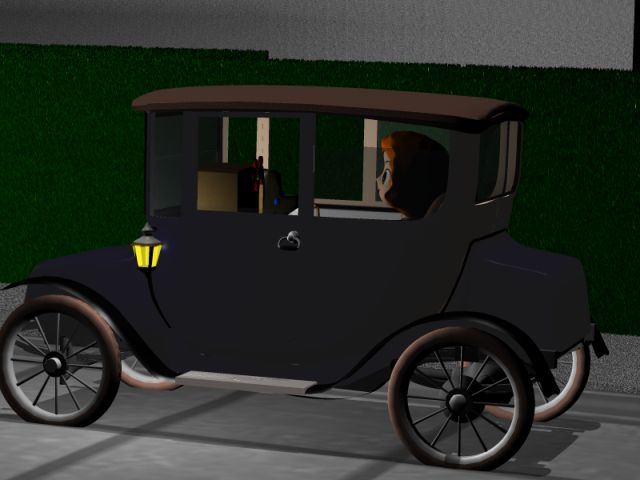 Coach lights were definitely useful because they were omnidirectional. You could measure the sides of the vehicle from front or back, you could see it from the side, and the light assisted passengers in finding the running board and doorhandle.
The big coach light turned into the cowl light, seen nicely on this '30 A:
Coach lights were definitely useful because they were omnidirectional. You could measure the sides of the vehicle from front or back, you could see it from the side, and the light assisted passengers in finding the running board and doorhandle.
The big coach light turned into the cowl light, seen nicely on this '30 A:
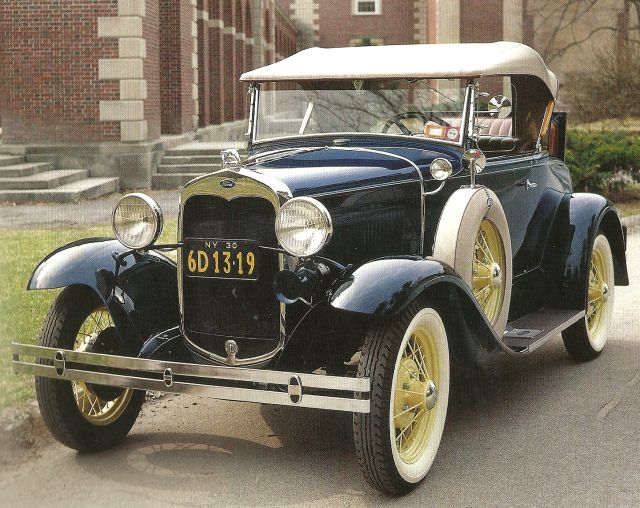 Cowl lights were purely decorative because they were focused strictly forward. They didn't illuminate anything you needed to see, and didn't mark anything that wasn't already marked by the headlights.
If the cowl light had been omnidirectional, or perhaps aimable from inside, it could have continued to serve the coach lamp purposes. For instance, cowl lamps pointing downward and forward would help in servicing the car:
Cowl lights were purely decorative because they were focused strictly forward. They didn't illuminate anything you needed to see, and didn't mark anything that wasn't already marked by the headlights.
If the cowl light had been omnidirectional, or perhaps aimable from inside, it could have continued to serve the coach lamp purposes. For instance, cowl lamps pointing downward and forward would help in servicing the car:
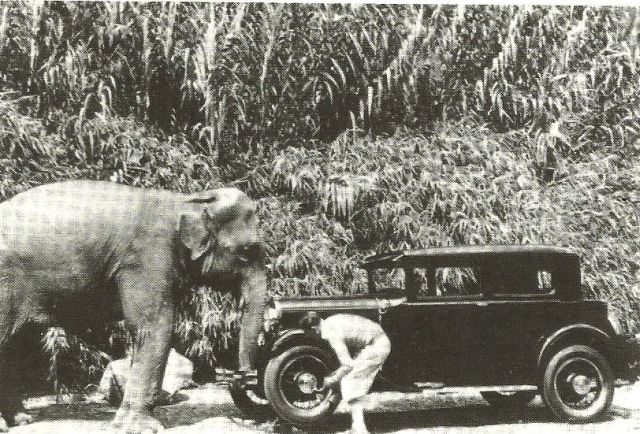 And cowl lamps pointing backward and upward could serve commercial purposes, illuminating your merchandise or signs:
And cowl lamps pointing backward and upward could serve commercial purposes, illuminating your merchandise or signs:
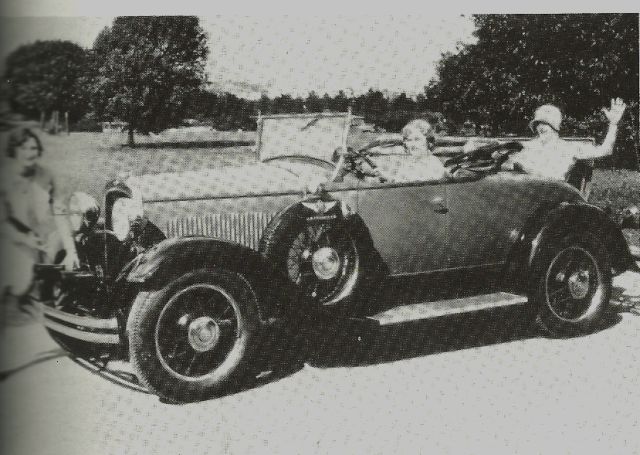 And a cowl lamp pointing down and back could have helped with picking up passengers. This picture seems to show a prototype of a 'crosshair' style test fixture to aim cowl lamps, but the lamp itself is clearly non-movable, so the test rig would have been useless.
And a cowl lamp pointing down and back could have helped with picking up passengers. This picture seems to show a prototype of a 'crosshair' style test fixture to aim cowl lamps, but the lamp itself is clearly non-movable, so the test rig would have been useless.
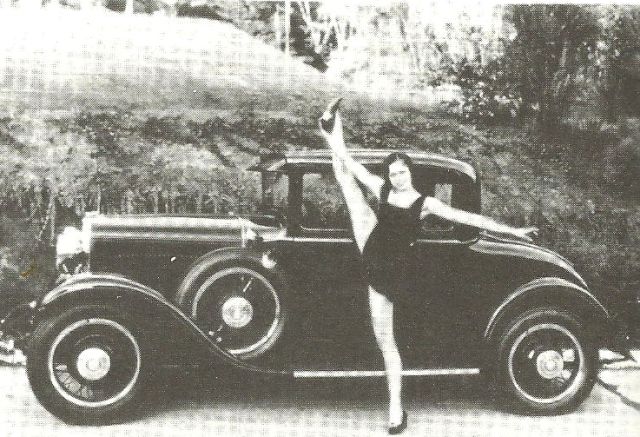 Around 1933 cowl lamps started to disappear, replaced instantly by parking lamps on the front fenders. The point of transition shows in this '33 Hudson Terraplane ad. One car with no lamps, one with cowl lamps, two with fender-mounted lamps.
Around 1933 cowl lamps started to disappear, replaced instantly by parking lamps on the front fenders. The point of transition shows in this '33 Hudson Terraplane ad. One car with no lamps, one with cowl lamps, two with fender-mounted lamps.
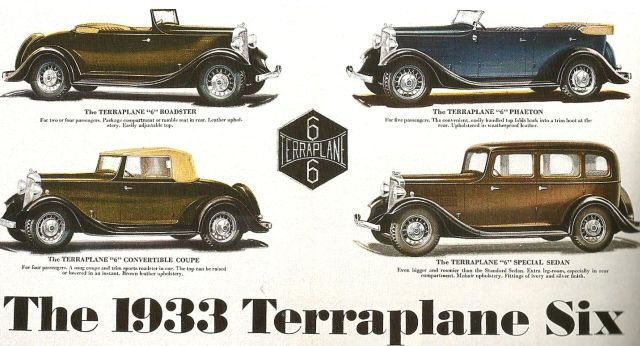 Several years after the fender position became normal, parking lights gained a partial purpose by adding a second filament for directional signals. In '41 Dodge followed Buick's lead in offering factory directionals. This '41 shows a distinctly logical placement of both parking lights and taillights, visible from all sides.
Several years after the fender position became normal, parking lights gained a partial purpose by adding a second filament for directional signals. In '41 Dodge followed Buick's lead in offering factory directionals. This '41 shows a distinctly logical placement of both parking lights and taillights, visible from all sides.
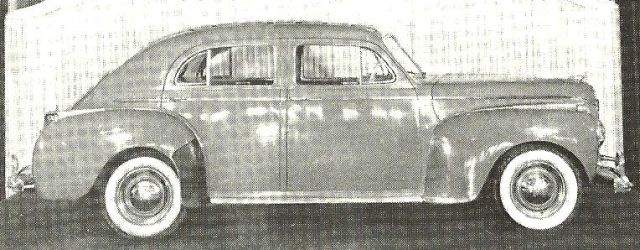 On a typical car of the 50s through 70s the Parking position on the light switch was actually WORSE than useless. If you weren't alert you could pull the knob out to the first click. You saw the dash lights and you saw some illumination in front, so you assumed the headlights were on.
So parking lights are solely useful as directionals, and occasionally as four-way flashers. But they still retain the vestigial Parking function, more harmful than helpful.
On a typical car of the 50s through 70s the Parking position on the light switch was actually WORSE than useless. If you weren't alert you could pull the knob out to the first click. You saw the dash lights and you saw some illumination in front, so you assumed the headlights were on.
So parking lights are solely useful as directionals, and occasionally as four-way flashers. But they still retain the vestigial Parking function, more harmful than helpful.
 After the driver moved firmly into the front, forward and sideways vision were usable. Backward vision took amazingly long to establish. Inside mirrors were standard by 1920, but essentially useless because the rear window was tiny, often too high to look downward, and often covered by shades or blinds. Rear windows finally opened up and straightened up in 1950.
The left side mirror was purely optional and rather rare until the mid-50s. Right side mirrors didn't become common until the '80s. Internal adjustments for both mirrors, especially the right one, were obviously needed and technically easy.... but weren't even available on luxury cars until the '60s and not standard until the '90s. Before these levers or motors, both mirrors were essentially impossible to adjust, which meant they were mostly useless.
Headlights also belong to the SEEING side, and developed in a 'logical' way, taking advantage of technology. From oil lamps to incandescent to halogen, getting brighter and more penetrating at each step.
Taillights, on the BEING SEEN side, were far less 'logical'. One taillight, sometimes centered and sometimes down low on the left side, was sufficient until 1935. This was stupid and dangerous. At night you need to see the BOUNDARIES of the car, and you need to judge how far it is from you. You need lights on both sides, preferably close to eye level, and out at the far edges of the car.
The least sensible of all is parking lights. Completely useless. Never served any purpose at all.
Parking lights developed from coach lights, as Polistra shows here.
After the driver moved firmly into the front, forward and sideways vision were usable. Backward vision took amazingly long to establish. Inside mirrors were standard by 1920, but essentially useless because the rear window was tiny, often too high to look downward, and often covered by shades or blinds. Rear windows finally opened up and straightened up in 1950.
The left side mirror was purely optional and rather rare until the mid-50s. Right side mirrors didn't become common until the '80s. Internal adjustments for both mirrors, especially the right one, were obviously needed and technically easy.... but weren't even available on luxury cars until the '60s and not standard until the '90s. Before these levers or motors, both mirrors were essentially impossible to adjust, which meant they were mostly useless.
Headlights also belong to the SEEING side, and developed in a 'logical' way, taking advantage of technology. From oil lamps to incandescent to halogen, getting brighter and more penetrating at each step.
Taillights, on the BEING SEEN side, were far less 'logical'. One taillight, sometimes centered and sometimes down low on the left side, was sufficient until 1935. This was stupid and dangerous. At night you need to see the BOUNDARIES of the car, and you need to judge how far it is from you. You need lights on both sides, preferably close to eye level, and out at the far edges of the car.
The least sensible of all is parking lights. Completely useless. Never served any purpose at all.
Parking lights developed from coach lights, as Polistra shows here.
 Coach lights were definitely useful because they were omnidirectional. You could measure the sides of the vehicle from front or back, you could see it from the side, and the light assisted passengers in finding the running board and doorhandle.
The big coach light turned into the cowl light, seen nicely on this '30 A:
Coach lights were definitely useful because they were omnidirectional. You could measure the sides of the vehicle from front or back, you could see it from the side, and the light assisted passengers in finding the running board and doorhandle.
The big coach light turned into the cowl light, seen nicely on this '30 A:
 Cowl lights were purely decorative because they were focused strictly forward. They didn't illuminate anything you needed to see, and didn't mark anything that wasn't already marked by the headlights.
If the cowl light had been omnidirectional, or perhaps aimable from inside, it could have continued to serve the coach lamp purposes. For instance, cowl lamps pointing downward and forward would help in servicing the car:
Cowl lights were purely decorative because they were focused strictly forward. They didn't illuminate anything you needed to see, and didn't mark anything that wasn't already marked by the headlights.
If the cowl light had been omnidirectional, or perhaps aimable from inside, it could have continued to serve the coach lamp purposes. For instance, cowl lamps pointing downward and forward would help in servicing the car:
 And cowl lamps pointing backward and upward could serve commercial purposes, illuminating your merchandise or signs:
And cowl lamps pointing backward and upward could serve commercial purposes, illuminating your merchandise or signs:
 And a cowl lamp pointing down and back could have helped with picking up passengers. This picture seems to show a prototype of a 'crosshair' style test fixture to aim cowl lamps, but the lamp itself is clearly non-movable, so the test rig would have been useless.
And a cowl lamp pointing down and back could have helped with picking up passengers. This picture seems to show a prototype of a 'crosshair' style test fixture to aim cowl lamps, but the lamp itself is clearly non-movable, so the test rig would have been useless.
 Around 1933 cowl lamps started to disappear, replaced instantly by parking lamps on the front fenders. The point of transition shows in this '33 Hudson Terraplane ad. One car with no lamps, one with cowl lamps, two with fender-mounted lamps.
Around 1933 cowl lamps started to disappear, replaced instantly by parking lamps on the front fenders. The point of transition shows in this '33 Hudson Terraplane ad. One car with no lamps, one with cowl lamps, two with fender-mounted lamps.
 Several years after the fender position became normal, parking lights gained a partial purpose by adding a second filament for directional signals. In '41 Dodge followed Buick's lead in offering factory directionals. This '41 shows a distinctly logical placement of both parking lights and taillights, visible from all sides.
Several years after the fender position became normal, parking lights gained a partial purpose by adding a second filament for directional signals. In '41 Dodge followed Buick's lead in offering factory directionals. This '41 shows a distinctly logical placement of both parking lights and taillights, visible from all sides.
 On a typical car of the 50s through 70s the Parking position on the light switch was actually WORSE than useless. If you weren't alert you could pull the knob out to the first click. You saw the dash lights and you saw some illumination in front, so you assumed the headlights were on.
So parking lights are solely useful as directionals, and occasionally as four-way flashers. But they still retain the vestigial Parking function, more harmful than helpful.
On a typical car of the 50s through 70s the Parking position on the light switch was actually WORSE than useless. If you weren't alert you could pull the knob out to the first click. You saw the dash lights and you saw some illumination in front, so you assumed the headlights were on.
So parking lights are solely useful as directionals, and occasionally as four-way flashers. But they still retain the vestigial Parking function, more harmful than helpful.
